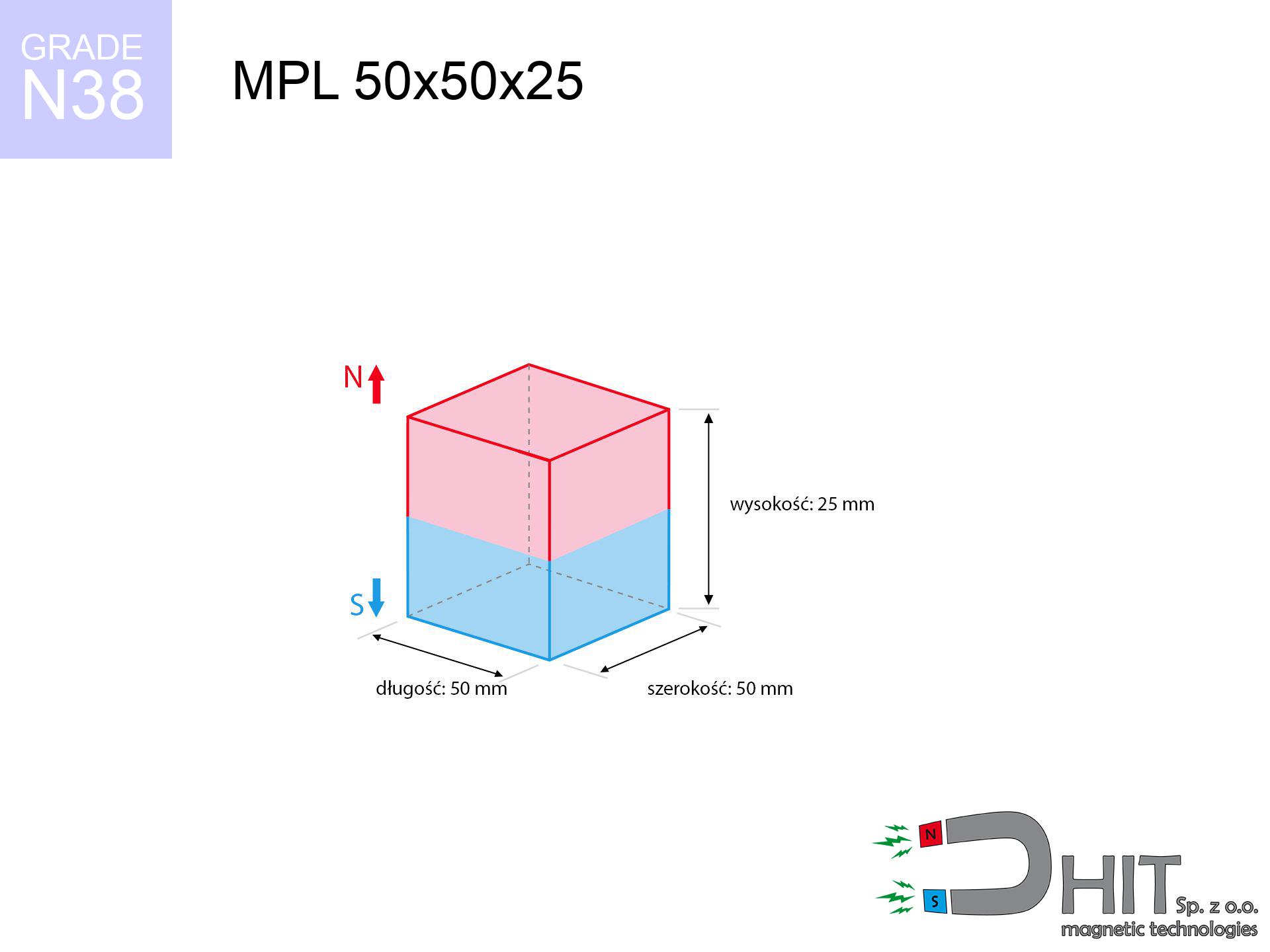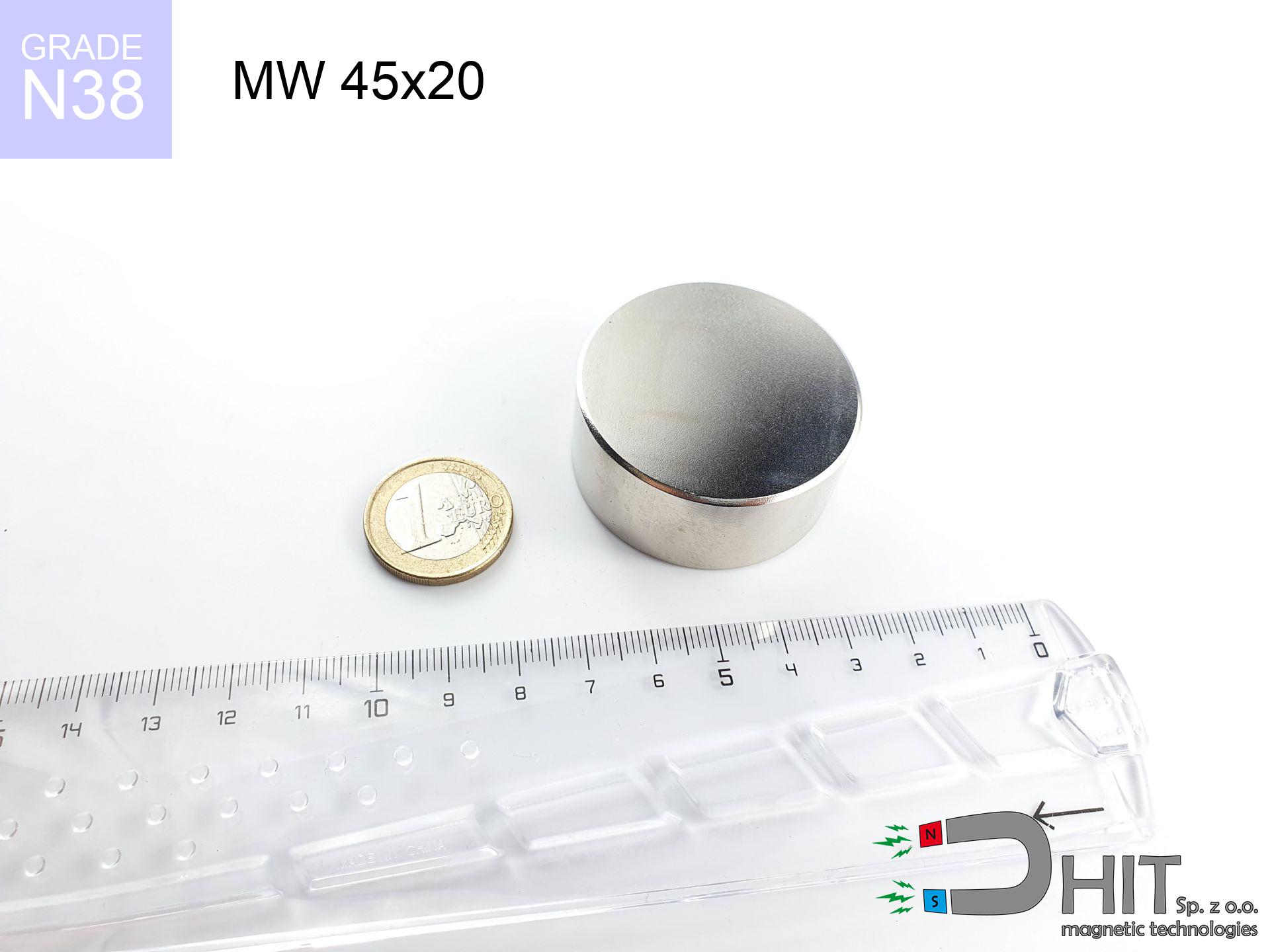MPL 50x50x25 / N38 - lamellar magnet
lamellar magnet
Catalog no 020168
GTIN: 5906301811749
length [±0,1 mm]
50 mm
Width [±0,1 mm]
50 mm
Height [±0,1 mm]
25 mm
Weight
468.75 g
Magnetization Direction
↑ axial
Load capacity
98.71 kg / 968.01 N
Magnetic Induction
413.25 mT
Coating
[NiCuNi] nickel
159.90 ZŁ with VAT / pcs + price for transport
130.00 ZŁ net + 23% VAT / pcs
120.31 ZŁ net was the lowest price in the last 30 days
bulk discounts:
Need more?Want to negotiate?
Contact us by phone
+48 888 99 98 98
if you prefer send us a note through
inquiry form
the contact section.
Lifting power along with structure of a magnet can be calculated on our
our magnetic calculator.
Order by 14:00 and we’ll ship today!
Magnetic properties of material N38
Physical properties of sintered neodymium magnets Nd2Fe14B at 20°C
Shopping tips
Pros as well as cons of rare earth magnets.
In addition to their pulling strength, neodymium magnets provide the following advantages:
- They have constant strength, and over nearly 10 years their attraction force decreases symbolically – ~1% (according to theory),
- Neodymium magnets are remarkably resistant to magnetic field loss caused by magnetic disturbances,
- By applying a decorative layer of silver, the element gains an nice look,
- Neodymium magnets achieve maximum magnetic induction on a small area, which ensures high operational effectiveness,
- Neodymium magnets are characterized by very high magnetic induction on the magnet surface and are able to act (depending on the form) even at a temperature of 230°C or more...
- Thanks to freedom in designing and the ability to modify to unusual requirements,
- Huge importance in high-tech industry – they are commonly used in magnetic memories, electric motors, precision medical tools, as well as technologically advanced constructions.
- Compactness – despite small sizes they generate large force, making them ideal for precision applications
Disadvantages of neodymium magnets:
- They are fragile upon too strong impacts. To avoid cracks, it is worth protecting magnets in a protective case. Such protection not only protects the magnet but also increases its resistance to damage
- We warn that neodymium magnets can reduce their strength at high temperatures. To prevent this, we suggest our specialized [AH] magnets, which work effectively even at 230°C.
- Magnets exposed to a humid environment can rust. Therefore when using outdoors, we recommend using waterproof magnets made of rubber, plastic or other material resistant to moisture
- We recommend casing - magnetic mount, due to difficulties in creating nuts inside the magnet and complex shapes.
- Possible danger related to microscopic parts of magnets are risky, when accidentally swallowed, which becomes key in the context of child safety. Furthermore, small elements of these magnets can complicate diagnosis medical in case of swallowing.
- Higher cost of purchase is a significant factor to consider compared to ceramic magnets, especially in budget applications
Maximum magnetic pulling force – what contributes to it?
Holding force of 98.71 kg is a theoretical maximum value conducted under the following configuration:
- using a sheet made of high-permeability steel, acting as a ideal flux conductor
- possessing a thickness of minimum 10 mm to ensure full flux closure
- characterized by lack of roughness
- under conditions of gap-free contact (surface-to-surface)
- for force acting at a right angle (in the magnet axis)
- in neutral thermal conditions
Impact of factors on magnetic holding capacity in practice
Effective lifting capacity impacted by specific conditions, mainly (from most important):
- Clearance – the presence of any layer (rust, tape, gap) acts as an insulator, which reduces capacity rapidly (even by 50% at 0.5 mm).
- Pull-off angle – note that the magnet holds strongest perpendicularly. Under sliding down, the capacity drops significantly, often to levels of 20-30% of the nominal value.
- Steel thickness – too thin plate does not accept the full field, causing part of the power to be wasted into the air.
- Material composition – different alloys attracts identically. High carbon content weaken the attraction effect.
- Surface quality – the more even the surface, the larger the contact zone and higher the lifting capacity. Roughness creates an air distance.
- Temperature influence – high temperature reduces pulling force. Too high temperature can permanently demagnetize the magnet.
* Lifting capacity was assessed by applying a smooth steel plate of suitable thickness (min. 20 mm), under perpendicular pulling force, whereas under parallel forces the holding force is lower. Additionally, even a small distance {between} the magnet and the plate lowers the lifting capacity.
Safety rules for work with neodymium magnets
Maximum temperature
Monitor thermal conditions. Heating the magnet above 80 degrees Celsius will permanently weaken its properties and pulling force.
Protect data
Intense magnetic fields can destroy records on payment cards, hard drives, and other magnetic media. Maintain a gap of at least 10 cm.
ICD Warning
For implant holders: Powerful magnets affect electronics. Maintain at least 30 cm distance or request help to handle the magnets.
GPS and phone interference
GPS units and smartphones are highly susceptible to magnetic fields. Close proximity with a powerful NdFeB magnet can permanently damage the internal compass in your phone.
Allergic reactions
Certain individuals experience a hypersensitivity to nickel, which is the common plating for neodymium magnets. Extended handling can result in an allergic reaction. We recommend use protective gloves.
Safe operation
Handle with care. Rare earth magnets act from a distance and connect with massive power, often faster than you can move away.
Product not for children
Always store magnets away from children. Risk of swallowing is high, and the consequences of magnets connecting inside the body are life-threatening.
Dust is flammable
Dust created during cutting of magnets is combustible. Avoid drilling into magnets without proper cooling and knowledge.
Serious injuries
Danger of trauma: The attraction force is so immense that it can cause hematomas, pinching, and broken bones. Use thick gloves.
Magnets are brittle
Despite the nickel coating, neodymium is brittle and cannot withstand shocks. Avoid impacts, as the magnet may crumble into hazardous fragments.
Warning!
Want to know more? Read our article: Are neodymium magnets dangerous?










